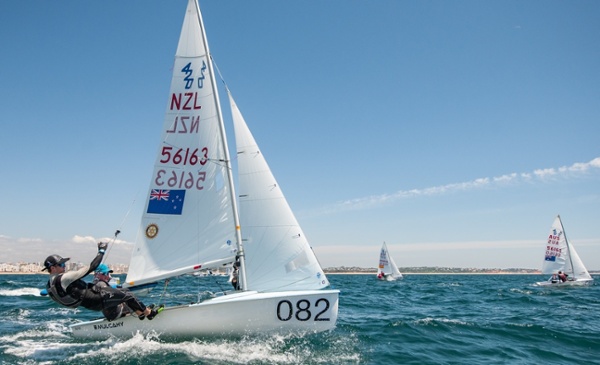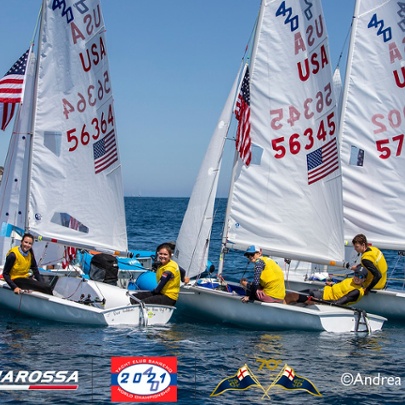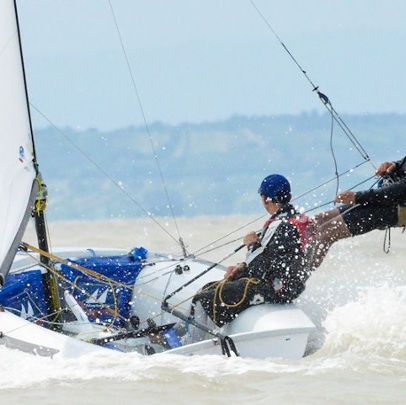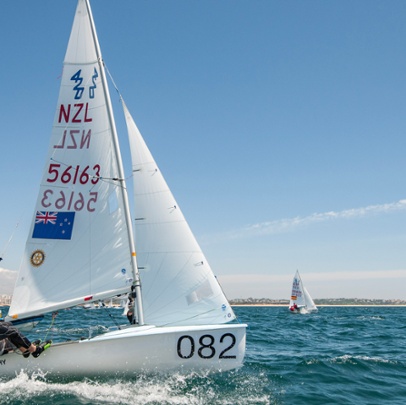The 420
Accelerate skill development in a boat that delivers an edge.
A Mackay 420 has been behind nearly every world champion success since we commenced building 420’s in 2012.
Specifications
Hull Length 4.2 m
Beam Length 1.63 m
Mainsail Area 7.4 m2
Headsail Area 2.8 m2
Spinnaker Area 9.0 m2
Boat Weight 100 kg
Hull Weight 80 kg
Hull Material GRP
No. of Crew 2
Opt Crew Weight 110 - 145 kg
Number of Trapeze Single
Designer Christian Maury
420 Class Association website: http://www.420sailing.org/
The Boat
The 420 is one of the best options to learn the ropes about two-person dinghy sailing. Crews learn how to tune a boat, set up control systems, trim sail combinations (jib, main and spinnaker together), work on downwind and upwind techniques, and importantly, learn how to work with another crew.
The Class has attracted many top sailors to it, providing a learning platform that has led them into successful Olympic campaigns and big boat careers.
The Hull
The 420’s design and class rules gave us the opportunity to build a boat similar to how the Mackay 470 is built in terms of the mould structure and look of the boat.
The Mackay 420 hull shape was developed by naval architect Kevin Trotter. Kevin has designed very fast dinghies here in New Zealand over the years. Using the latest design and analysis software, along with the luxury of time we were able to evaluate the expected performance along with the look of the boat.
Looking at where crews tended to sit in the boat in different conditions affected where we pushed the displacement curve of the boat. Additionally, Kevin's skiff designs gave valuable insight into the way the rocker curve and buttocks lines should run through the middle and aft sections.
The hull is made from a polyester e-glass fibre, using foam core ribs and core mat panels.
The Mackay 420 deck to hull joint system is the same as our 470s, which allows for the same exceptionally strong but light gunwale arrangement. This extends around the bow and across the transom.
We have also borrowed some other features off the 470. As an example, the way the mast partner is fitted to the deck after the boat is built allows the bulkhead in front of the mast to be more vertical and closer to the mast. This is better for rig tension and weight distribution. It also improves the look of the boat giving it a longer foredeck.
The Foils
The rudder stock is in cast aluminum which provides excellent support. The foils are built in the same way as our 470 foils by resin infusion.
Most importantly the time and energy we put into the rudder and centreboard design along with the finishing of the moulds has resulted in some very special foils.
Small gel coat repairs are relatively easy to do.
What is Gelcoat made up of?
Gelcoat is a polyester product that is cured by using a catalyst called MEKP. (Methyl Ethyl Ketone Peroxide)
MEKP is a dangerous substance and should be treated as such when using, being very careful not to get any on your skin or in your eyes.
How can I get the catalyst - MERK?
We cannot ship MEKP so you will always need to buy it separately from your local marine store or fibreglass manufacturer.
How much MERK do I need?
The amount of Catalyst varies depending on the conditions you are using it in, but around 2%-3% will always work.
It is best to use a small syringe or dropper to get the required catalyst rate.
If you have mixed 100gm of gelcoat, then you are aiming for 2ml of catalyst.
What are the Gelcoat colours?
Gelcoats colours are not always a 100% perfect match.
Colour will vary depending on the depth of the repair and the batch.
470, 420, 29er & Starling are built from polyester resin.
For Polyester boats
470 White- LS30 White PA 337
470 Grey- Grey RAL 7035
Blue = is supplier by Nuplex who have their own code which is not an international code
Does Mackay Boats supply gelcoat?
We supply a small tin (of each relevant colour) with each new boat.
Order additional gelcoat from our store, although it cannot be shipped by courier.
How do I do gelcoat repairs?
Doing gelcoat repairs is an art that improves with experience.
Making sure the surface is prepared well and keyed up is critical.
Overfill and then sanding back is a slow and time-consuming process.
Be very careful not to scratch the boat around the repair.
You shouldn’t sand the original surface around the repair with any paper coarser than 600grit.
Mask around the repair to protect the boat.
You can initially use a file or 150g to take the high parts off the filling, but don't use the coarse paper for too long or you will end up with scratches in the finished repair.
Once you have it fair with 600g, you can work your way through the sandpaper grades until you finish with 1500grit before cutting and polishing.
We would typically use 600g, then 800g or 1000g, then 1200g, then finally 1500g.
Deck colour and non-skid on the side-decks. You can find these options if you try the boat configurator on our website.
White, Light Grey, Light Blue, Light Green, and Cream. On the 420, Grey is the most popular, with Blue and White equal second most popular.
Please watch this short video that demonstrates fitting a mylar gasket to the 420 hull -












